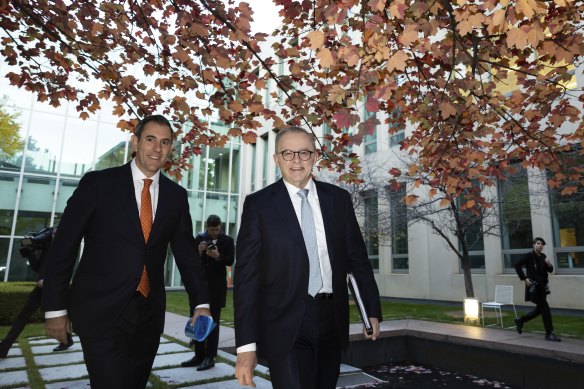Save articles for later
Add articles to your saved list and come back to them any time.
It has to be said that, apart from a notable exception, the less you earn, the better you did in Tuesday’s budget.
That exception was the long-planned stage 3 tax cuts for middle and higher earners, which remained untouched despite intense lobbying to drop them.
Treasurer Jim Chalmers and Prime Minister Anthony Albanese arrive for breakfast television interviews the day after the budget.Credit: Alex Ellinghausen
But the “responsible, targeted relief” in Labor’s $14.6 billion cost of living plan aims to help those struggling hardest with energy prices, health costs and affordable housing, as well as support Australians who are vulnerable in other areas.
Let’s break it down to the bottom-line benefit.
Energy: First up in Tuesday’s speech, we were directed to remember the price cap placed on coal and gas prices and told of its bill-limiting success.
Then there were two explicit, extra moves to ease the purse hurt.
Firstly, more than 5 million eligible households will receive as much as $500 off their power bills next financial year, co-funded by the states and territories.
The second measure is an investment in low-cost loans for double glazing and solar panels that will make homes easier to heat and cool.
You need to be on benefits to qualify for the rebates. Speaking of which…
JobSeeker: From September, not just JobSeeker but Youth Allowance and Austudy recipients will receive a $40-a-fortnight rise, or $2.86 a day.
This brings the day rate for JobSeeker from $49.51 to $52.37 (for singles under 55). Those living away from home and on Youth Allowance will get $43.06 a day (also for singles). Critics argue that is still well below the poverty line.
There is a higher rate of JobSeeker that is paid from age 60, which will now begin at 55.
This is one of a suite of changes implicitly designed for women, who in this age group – and especially if single – are at higher risk of homelessness. Payments for older Australians will move from $53.02 a day to $56.09.
Compared to the extra $2.86 a day, stage 3 tax cuts will mean an extra $25 a day for high-income earners.
Parenting payment: The government has partially reinstated a higher age for payments to cease, from eight to 14 (a decade ago, it was 16).
Again from September, the base rate of parenting payment (single) also goes up to $922.10 a fortnight, $65.86 a day.
Once more, this move particularly benefits women, who make up 91 per cent of claimants.
You are eligible for the full amount below earnings of $5907 a year; payments cut out at $68,820.
The ParentsNext program to keep payments, which requires checking in, reporting and training, will be phased out and replaced by a less onerous program from July 2024.
Health: One of the few surprises in the budget was a tripling in the incentive for a GP to bulk bill patients, including children under 16, pensioners and other Commonwealth concession card-holders.
The incentive is valid for face‑to‑face, telehealth and videoconference appointments.
Also potentially helping your health outlay, and ability to actually see a medical professional, is further funding for the Medicare Urgent Care Clinics set up in the October budget, bringing the number of clinics to 58 by year’s end.
The idea is that in these clinics you can get emergency, after-hours, free treatment for things such as broken bones, rather than going to stretched hospital emergency departments.
There will be cost relief on some medicines too: you will be able to buy two months’ worth for the price of a one-month prescription on more than 300 common Pharmaceutical Benefits Scheme medicines. The government expects this to also halve patients’ visits to pharmacists and GPs, freeing up appointments.
Rent: It’s all about being on the “system”, yet again, with a 15 per cent rise in Commonwealth rent assistance that is paid if you are on benefits and qualify. But this is only $31 a fortnight, and rents have increased far more.
Regarding larger, structural measures to fix the housing supply shortage, the government continues to try to get its Housing Australia Future Fund, to build more social and affordable housing, through the Senate.
Bottom-line verdict: On the other side of our personal balance sheets is, of course, the money we can make. We are told the news is good.
Wages growth for 2023-24 is forecast to be 4 per cent, up a quarter point since October’s budget. With inflation ticking down too, real wage growth may be inching closer.
That and this week’s narrowly targeted budget measures will alleviate the hip-pocket pain for some. Slowly.
- Advice given in this article is general in nature and is not intended to influence readers’ decisions about investing or financial products. They should always seek their own professional advice that takes into account their own personal circumstances before making any financial decisions.
Nicole Pedersen-McKinnon is the author of How to Get Mortgage-Free Like Me. Follow Nicole on Facebook, Twitter or Instagram.
Most Viewed in Money
From our partners
Source: Read Full Article

